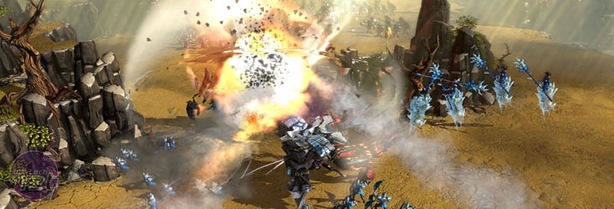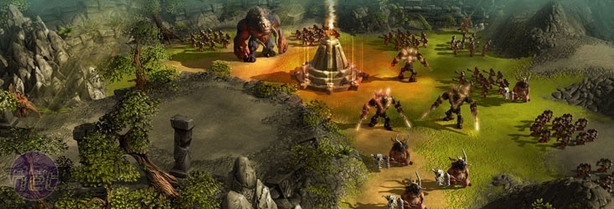
Fuel of War
Strategy in Battleforge is a lot more complex than you might think though – just because there aren’t any build queues and you can pick your own units doesn’t mean that you can just spam epic-level infantry onto the battlefield and send them charging.The first barrier to this method is the necessary resource gathering that fills the game and makes sure you can’t just drop your most powerful attacks and buildings down willy-nilly.
Every card in Battleforge has a power-price attached to it and unless you meet that single magic quota you’ll be unable to summon so much as a sense of lethargy. The lower units, such as basic infantry, archers and so on, have very meagre power requirements attached to them. The epic-level and ultra-rare cards however, such as Juggernaut and Behemoth, come with much steeper energy requirements.
Magical energy itself however is a constantly refreshing and very abundant in-game item though, forever spouting out of various towers and geysers across the landscape of the impressively large levels.
As with other strategy games like Company of Heroes then, harvesting isn’t done by sending out trucks to get the magical version of tiberium. Instead you have to grab hold of these magic-spewing towers and keep a grip on them as long as you can, constantly trying to dodge filthy innuendoes.
Doing that will be harder than it sounds though (again with the rude jokes), as these magical fonts are heavily contested areas and the level design serves to greatly funnel action towards them from what we’ve seen.
In the few levels we got a chance to see it looks like whoever was currently defending these areas was put at a definite disadvantage, with ownership switching back and forth faster than...agh, it’s no good. The only jokes we can think of now are rude ones. Don’t blame us – blame whichever designer at Phenomic thought they could get away with including magical towers that vomited gobs of white stuff out of the top.
The second thing that heavily impacts the strategy of the moment-to-moment gameplay is naturally the level design. There’s nothing surprising there but, from what we saw, the type of levels being used weren’t what you’d expect at all. In most RTS games there’s generally a fairly large area somewhere on the map, either with all paths leading to it or something enticing like an enemy base situated there. It’s this that becomes the main battlefield for the match.
Battleforge however seems to do things a little differently, with levels having lots of more narrow corridors and more regular, but less massive openings that are more suited to occasional skirmishes than full-blow battles.
When you think about it though, this focus on lots of smaller battles and a more gradual, creeping process through the levels makes a lot of sense. There’s a natural limit to how many units you can build in a match, so using the level to prolong the round into smaller skirmishes is definitely preferable to losing all your units in one single big fight and being unable to muster a counter attack fast enough.
The level design is also strangely suited to co-op gameplay too, which Battleforge puts a heavy emphasis on as a way of balancing out the total lack of singleplayer. If there are multiple small routes through a level then the best way to proceed is usually with an ally helping you cover them all – pushing communication and teamwork into the mix. Just be sure to check you and your ally have a deck that complement each other well!

MSI MPG Velox 100R Chassis Review
October 14 2021 | 15:04











Want to comment? Please log in.